


Framed or unframed, desk size to sofa size, printed by us in Arizona and Alabama since 2007. Explore now.
Shorpy is funded by you. Patreon contributors get an ad-free experience.
Learn more.

- Alas, hidden from view
- Exclusive pump
- Details, Details
- What's that building to the left of the tower?
- Coal Barges
- Bromo-Seltzer
- Inner harbor
- The Basin
- What a headache!
- Giant stepladder?
- Baldwin 62303
- Baldwin VO-1000
- Cold
- No expense spared
- Tough Guys
- Lost in Toyland
- And without gloves
- If I were a blindfolded time traveler
- Smoke Consumer Also Cooks
- Oh that stove!
- Possibly still there?
- What?!?
- $100 Reward
- Freeze Frame
- Texas Flyer wanted
- Just a Year Too Soon
- WWII -- Replacing men with women at the railroad crossing.
- Yes, Icing
- You kids drive me nuts!
- NOT An Easy Job
Print Emporium
Main Street U.S.A.: 1925
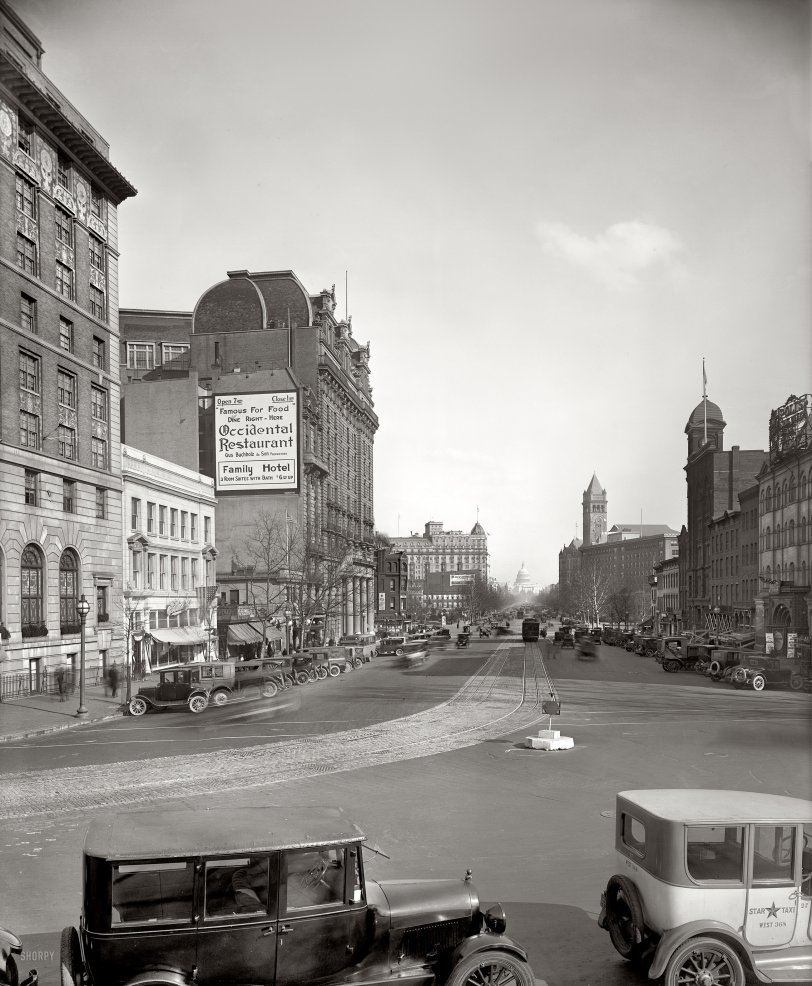
March 1925. Washington, D.C. "Pennsylvania Avenue." Lots of Shorpy landmarks here. Harris & Ewing Collection glass negative. View full size.
Wires You Can't See and other trolley trivia
Hey y'all, I just joined up and in going through the photos found this one of the Washington DC streetcar system. As I am a railroad historian and transit consultant I know a bit about this system.
Indeed Washington DC had electric streetcars. The Washington Streetcar System, began in 1862 and operated with mule power affectionately called "hay burners." In 1890 Washington got swept up in the Cable Car Craze. This is very odd because successful electric cars were in operation by 1886 and by 1890 most larger systems were either converted or in the process of converting. Cable Cars on the other hand were outrageously expensive to build, operate and maintain.
Though they once blanketed the country their era was only about 10 years, usually between about 1875-1885 when electric experimentation took the wind out of cable railroads. Washington's experimentation into cable railroading was short lived and represented a gigantic investment in what was already an out dated technology. Cable railway cars have no motors or other power source, they are simply free rolling rail cars not unlike the older mule cars. The big breakthrough was the wire rope cable that ran in a slot in the center of the street. The operator, called a gripman, would apply a mechanical gripping device which was under the center of the track in the street. The grip was controlled by a lever running from the car down into the rope-way. The cable never stopped moving, powered by a large steam engine turning giant pulleys with miles of continuous cable rope down in those slots. Grip operators had a choice of a full contact grip for forward momentum, a slip grip for slowing, and a full release when stopped.
When Washington electrified its municipal railways, there was great concern that overhead wires might make the views of the national monuments rather tacky.
Certainly the cable railway suppliers had every reason to push this view on the public. The whole argument came to naught as it was decided to run the electric cable in the center of the street. A trolley pole on the bottom of the car contacted the wire providing energy for the large motors on the electric trolleys. Today Washington like most other cities is rebuilding its streetcar system, but this time around it will have wires ABOVE the tracks.
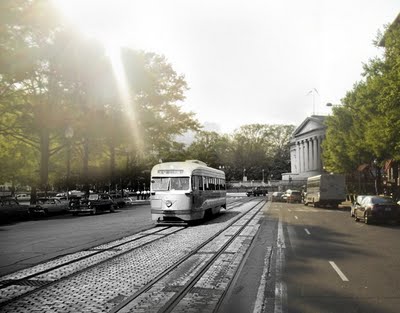
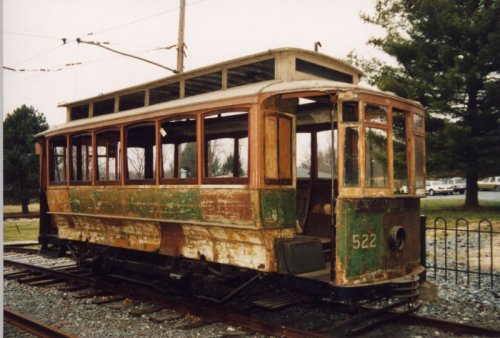
Childs' Restaurant
I spent the longest time trying to make out the letters on the lighted sign on the white building to the left. I should have known I could more easily find an alternate view in Shorpy's archive. The building is Childs' Restaurant, now with three stories! Also in the archive is nice photo of the Occidental Hotel.
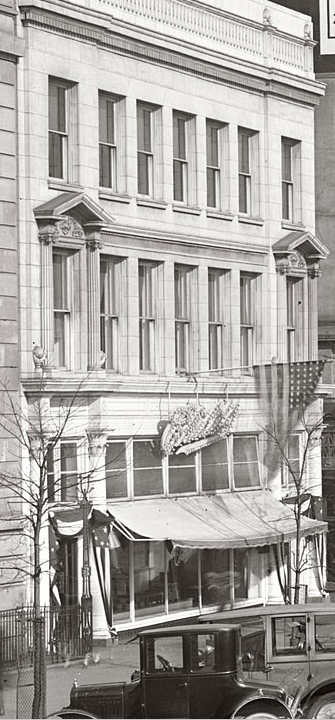
Department store
You can just see a sign for Raleigh's on the top of the building just left of center, above the Jacksonville sign. Raleigh was a Washington, DC department store that finally went out of business in 1992. I remember my mom having a Raleigh's charge card back in the 1970s.
[The RALEIGH sign is for the Raleigh Hotel. Raleigh Haberdasher was a tenant on the ground floor. - Dave]

Who they yam
"I think I see Lincoln in the series of portraits just under the cornice of the building on the left. But who are the others?"
The man on our right (Abe's left) is definitely George Washington. The fellow on the left is a puzzler - presumably another president, but he looks like Socrates. Or maybe Popeye.
More Landmarks
Other Shorpy hallmarks included here: ghosts on the sidewalk, vintage cars & streetcars in action, funky roadsigns, promotional posters for upcoming events, and a glimpse into a long-gone way of life.
Location
I don't think that's the Willard on the left. The building to the farthest left is the Washington Hotel, at 15th and Penn. It's still there and looks the same. The White House and the Willard would be in back of the photographer. The Post Office tower is still there, but the buildings on the far right have been replaced by the District Building, the DC town hall.
[The Willard is indeed in this photo, at 14th and Pennsylvania, rising next to the much smaller Occidental Hotel. - Dave]
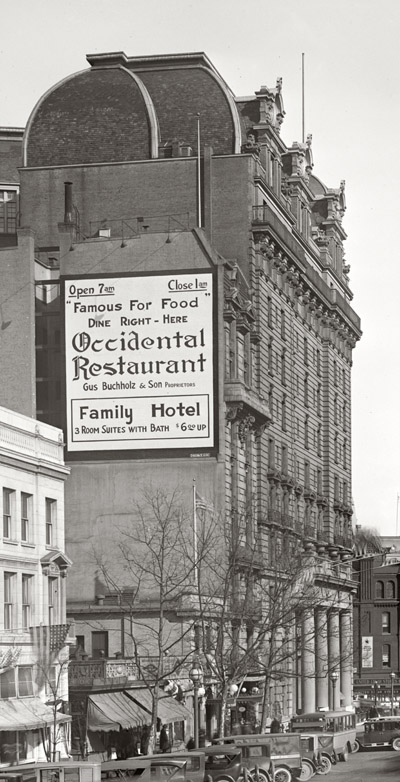
No wires for the trolley.
No wires for the trolley. Were these not electric?
[They were electric. The wires were under the street. - Dave]
That one in the background is still there
Looks like I've found my new desktop background. Whenever I place a Shorpy picture for my desktop background, I also find a modern day version of the same pic to show anyone who asks about my black and white background. So, here's the Street View. Enjoy!
Legibility: what a concept
"Henry, what does that sign in the middle of the street say? I can't make it out."
"Me neither, Martha. It'll be on your side when we go past, see if you can read it."
The Occidental
A restaurant "famous for food" -- what will they think of next?
My Favorites
My two favorite Shorpy subjects are here. Both the U.S. Capitol and a United Cigar Store.
Thankyou very much
Just spent two whole days going back through the whole archive ... quite wonderful ... thanks.
[You're welcome, and the bathroom's at the end of the hall. - Dave]
$6 hotel suites
What do they think -- we're made of money?
Who are they?
I think I see Lincoln in the series of portraits just under the cornice of the building on the left. But who are the others?
Whew
So much to look - I love these street scenes. Love the landmarks.
Neat
Photo is taken at just about the same spot as that KKK march photo of some time back. And there's the Willard in all its glory. Amazing how bright he Occidental sign is, like it was highlighted.
























On Shorpy:
Today’s Top 5